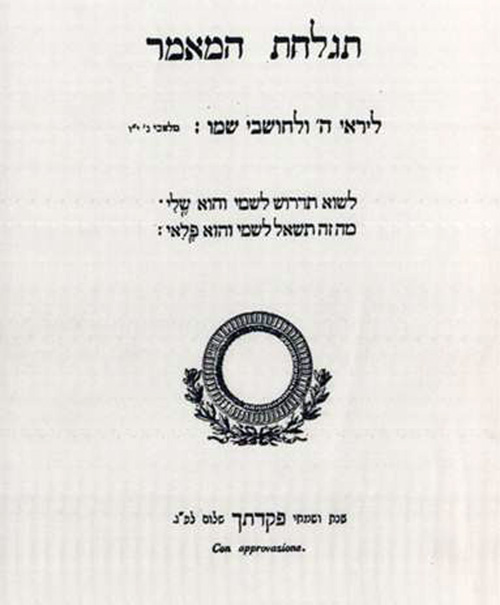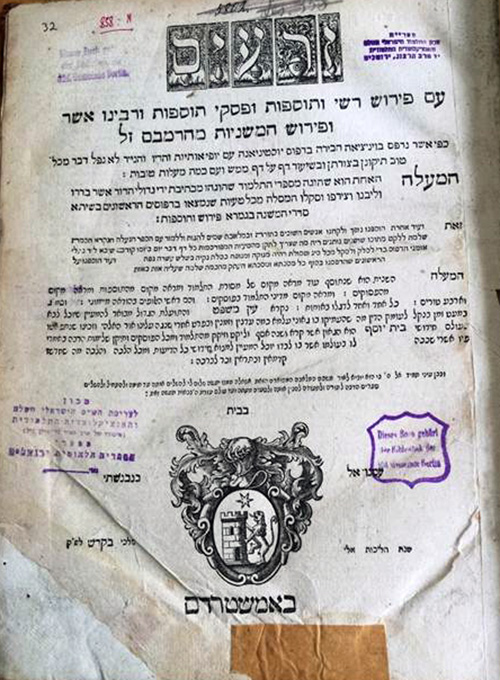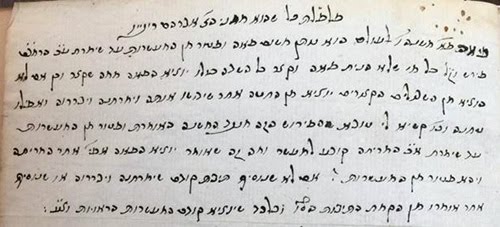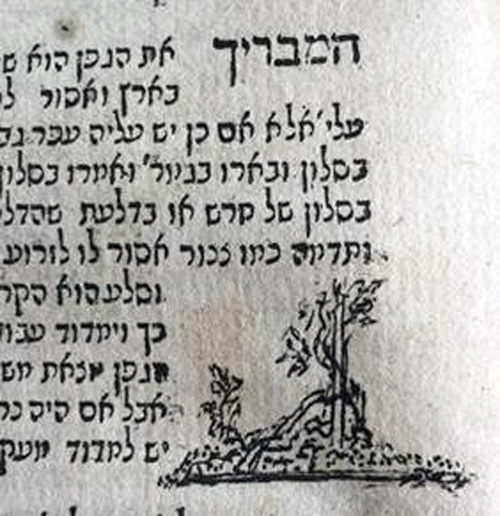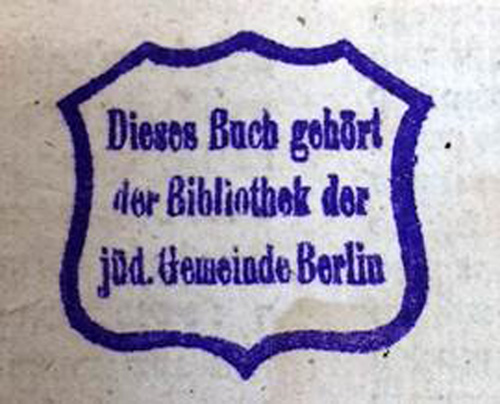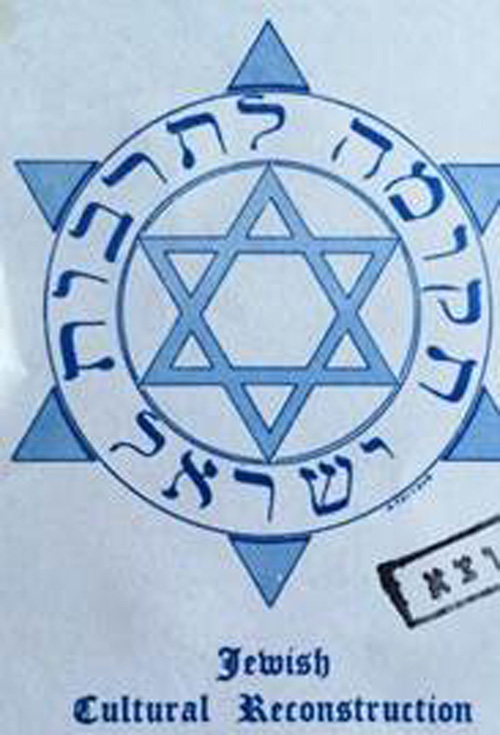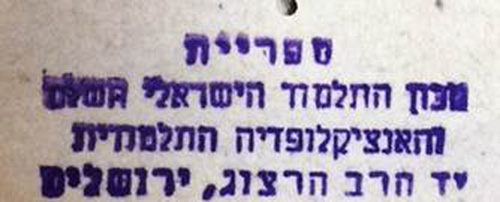Rav Avraham Chai Reggio Brings A Sefer To Life
Bouskila of Congregation Netivot Israel in Brooklyn for helping me decipher
Rav Avraham Reggio’s handwriting
northern Italy for over forty years. During that time period, he answered
Sha’aylot both locally and from abroad, wrote a Sefer Torah, performed 300 circumcisions,
and gave many Drashot that changed people’s lives.[1] We are told that the
Derashot he gave before Neilah were so inspiring that
townspeople ascribed their being saved from a Cholera epidemic by Rav Avraham’s
righteousness.
shaving on Chol Hamoed called “Tiglachat Hama’amar” printed anonymously in Livorno
(either 1839 or 1844) which was a refutation of his son Isaac Samuel Reggio’s book “Ma’amar HaTiglachat” (Vienna 1835 ) which
argued for permitting it.[2]
was that “times have changed”, therefore the Halacha could be different. Rav Avraham responds to this argument and
writes as follows about changing the Halacha:
in 1646 as part of the printing of the entire Babylonian Talmud by Immanuel
Beneveniste.
title page, but aside from those marks of ownership, we know that the book at
one time belonged to Avraham Reggio by this handwriting on the back page.
ממני הז׳ אברהם ריגייו
משום פיאה ופטור מן המעשרות עד שימרח ע״כ
ז׳ק׳ל שכל מי שלא הניח פיאה וקצר כל השדה
כלו יוציא הפיאה ממה שקצר וכן אם לא הוציא מן השבלים הקצורים יוציא מן החטה אחר
שידושו אותה וימרחוה ויבררוה ואפילו טחנה וכו׳
שהפירוש הזה מנגד המשנה האומרת ופטור מן המעשרות עד שימרח. א״כ המריחה קובע למעשר. ומה זה שאומר יוציא הפיאה אפי׳ אחר המריחה ויהא
פטור מן המעשרות!
לא שנוסיף תיבת קודם שימרחנה ויבררוה או שנוסיף אחר
אומרו מן הקמח
התיבות כלו׳ ובלבד שיוציא קודם המעשרות
הראויות וצ״ע
and deals with whether Maaser has to be taken from that which is designated as
Peah. Rav Avraham understands from his reading of the Peirush Hamishnayos on
this Mishneh, that the position of the
Rambam is that Maaser does not have to be separated from that which is
designated as Peah even after Merichah has been done.[3]
question, it is clear That Rav Avraham understands the Rambam to be saying that
you are obligated to separate a portion for Peah even after the flour made from
harvested wheat is ground and that you are never obligated at any stage to
separate Ma’asrot. This is not clear to me from the Lashon of the Rambam who might
be saying normally one does not have to separate Maaser from Peah and adding
that Peah always has to be separated even at the latest stage of crop
production. The Rambam actually makes his comment דע שהפאה לא תחחייב להוציא ממנה מעשרות
on our Mishneh which says לעולם הוא נותן משום פיאה ופטור מן המעשרות
עד שימרח.
One would have to agree though, that
the Lashon of the Rambam is confusing.
many diagrams that are drawn by hand in the book which fill in the blank spaces
left by the printer. Here is an example of a fairly complex one which I believe
was drawn by Rav Avraham Reggio.[4]
particular volume of Mishnayot needed some special Siyata D’Shemaya to survive
the Nazi annihilation of both Jews and their property. After being owned by Rav
Avraham Reggio, the book was the property of the library of the Jewish
community of Berlin.
informed by the present day website of the Berlin Jewish Library that most of
the holdings belonging to this library did not survive the war. This makes this
book akin to an ״אוד מוצל מאש״ (זכריה ג:ב).
“The library of the Jewish Community of Berlin was founded in 1898. It opened its doors in 1902 in the community’s administration building on Oranienburger Strasse and quickly became a highly popular scientific resource, open to Jewish community members and the general public. By the time the National Socialist regime dissolved the Jewish community and forced its library to close, the institution had nine branches with more than 100,000 volumes, nearly all of which were lost in the war.”
The book became part of the restitution efforts of the Jewish Cultural Reconstruction after the war and was eventually sent to Israel to be part of the library of the “Encyclopedia Hatalmudit”
possible that just as Rav Avraham Reggio saved his town from a cholera
epidemic, that his writings saved this book from being destroyed in the war?
main source for his biography is from a series of two articles written in the
journal “Yerushalayim HaBenuyah” printed in 1844( Choveret Rishon, Zolkiew) and
1845 ( Choveret Sheniyah, Lemberg) The articles appeared under the title of
“Toldot Avraham” whose author was Mordechai Shmuel Ghirondi (1800-1852) Ghirondi
laments at length the loss of his teacher and goes into great detail of his
life. The two specific example cited above are on page 80 of the “Choveret
Rishon”
For a discussion on shaving on Chol
HaMoed including quotations from both Avraham and Isaac Reggio’s books see
here.
Tiglachat Hama’Amar comes from the Israel National Library website.

Note the date of death of 1846
which is incorrect as the eulogies on him by Mordechai Shmuel Ghirondi appeared
starting in 1844. Ghirondi gives the date of death as Asarah b’Tevet in 5602 (
1841). I am confused as to the date of publication of Tiglachat Maamar as the
NLI site gives it as תקצ“ט but פ’ק’ד’ת’ך’ would indicate (5)604 or 1844. This date
is what is listed in Beit Eiked Sefarim.
is understood by the various Meforshim. (From Mishnayot Zecher Chanoch) As you
can see, Rambam’s definition differs from other Meforshim.
know he was a Sofer and the ink looks very similar to writing in the back of
the book. (Additionally, his son Isaac Samuel was a skilled artist, and perhaps his artistic talent ran in the family. – Ed.)

